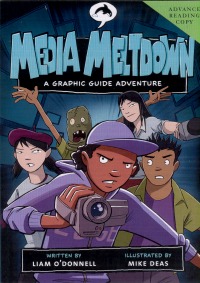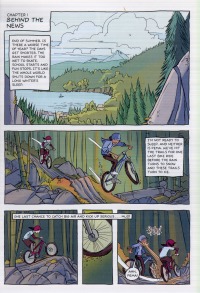| ________________
CM . . .
. Volume XVI Number 2. . . .September 11, 2009 
 |
Media Meltdown. (A Graphic Guide Adventure).
Liam O'Donnell. Illustrated by Mike Deas.
Victoria, BC: Orca, 2009.
64 pp, pbk., $9.95.
ISBN 978-1-55469-065-7.
Subject Heading:
Media literacy-Comic books, strips, etc.-Juvenile fiction.
Grades 6-10 / Ages 11-15.
Review by Ruth Sands.
***½ /4
Reviewed from Advance Reading Copy.
|
| |
|

excerpt:
Inside my dad's showroom, the trucks were long gone. Wind turbines and solar panels took their place.
"I started this business only a few months ago, Ms. Searles, so I'm very eager to tell the whole city about it."
"Advertising is all about getting attention, Mr. Sharp! My ideas will definitely spread the word and boost sales of all your products."
"There are many ways we can promote your alternative energy sources. Each one is guaranteed to grab the viewer's attention!"
"She's talking about advertising hooks. Megan told me all about them."
"Why do you call them hooks?"
"Ever go fishing? Like a shiny lure, ads are dangled in front of us, tempting us to take a bite."
"Once our attention is 'hooked,' advertisers can send us their message."
Humor is an effective hook because we like seeing things that make us laugh, and advertisers know it.
Ads show happy people to make us feel happy when we see the product. These ads make us feel strongly about a product without telling us anything about it!
Advertisers play on our fears of being left out or not being cool. They tell us their product is the solution and if we have it we'll "fit in" and be cool.
Advertisers grab our attention with outrageous claims that can't be disproved. Look for the small print to find the "truth" about these false promises.
Celebrities appear in ads because many people look up to them and will listen to what they say. The stars get something in return: money!
Advertisers know that exposed skin will get our attention. But it also gets a lot of people angry and makes them not want to buy that product.
"Those are just some of the hooks advertisers use to get our attention. When you can recognize the hook, you can understand how the ad is working."
Media Meltdown is the latest installment of the "Graphic Guide Adventures" by writer Liam O'Donnell and illustrator Mike Deas. When an agent for Oasis Developers puts unscrupulous pressure on Jagroop's father to sell the family farm, Jagroop and his friends, Pema and Bounce, try to take their message to the news-viewing public. When they are stopped by the power of the advertising dollars and old friendships, they have to find another method to reach their audience. While trying to solve the mystery of who set fire to the barn, and thereby clear the names of teenagers all over, the group learns what really happens to the news we see and how we can be more knowledgeable viewers.
 While Jagroop and the gang are trying to solve the mystery of the burnt barn and how to get their message out, Liam O'Donnell is teaching the reader about several different areas of news media. The gang first learns about the running of a news station and the different stages a story will go through before hitting the airways. Then, as Bounce's dad is starting up a new business, they learn about how advertising works. When their story gets shortened and slanted to make the wrong people look guilty, the gang learns how advertising dollars and the owners' personal biases determine exactly what the public gets to see. In a last attempt to get their message out, Bounce explores the internet and discovers several alternatives to mainstream newscasting. While Jagroop and the gang are trying to solve the mystery of the burnt barn and how to get their message out, Liam O'Donnell is teaching the reader about several different areas of news media. The gang first learns about the running of a news station and the different stages a story will go through before hitting the airways. Then, as Bounce's dad is starting up a new business, they learn about how advertising works. When their story gets shortened and slanted to make the wrong people look guilty, the gang learns how advertising dollars and the owners' personal biases determine exactly what the public gets to see. In a last attempt to get their message out, Bounce explores the internet and discovers several alternatives to mainstream newscasting.
O'Donnell has found a unique way of teaching kids. The illustrations in the graphic guide are solid and modern and will really appeal to children today. The information is well-researched and well-balanced, showing both the unique nature of the Internet as a vehicle for news, but also the pitfalls that are singular to the World Wide Web. Media Meltdown is perfect for reaching out to today's youth as they are bombarded with advertising and news from a million different sources. The graphic guide does a good job of impressing upon the reader the need to be a discerning consumer of news and advertising. Besides, Media Meltdown is fun. It has all the good qualities of a comic book while imparting to the reader a lot of useful information.
As good as the guide is, I did have one problem and that has to do with the portrayal of the weather girl. I was quite disappointed to discover that in a book that is trying to illuminate the problem of news bias and news filtering that there would be the promotion of such a stereotype. Not all weatherpersons are blond, ditsy, airheads as the story would have you believe. Although I realize that the stereotype works for the story, I would have expected there to be a more realistic portrayal of a meteorologist or weatherperson.
Overall, Media Meltdown is a very entertaining and informative graphic novel and is sure to impress and instruct a generation of computer savvy children.
Recommended.
Ruth Sands is a freelance writer from Vancouver, BC.

To comment
on this title or this review, send mail to cm@umanitoba.ca.
Copyright © the Manitoba Library Association. Reproduction for personal
use is permitted only if this copyright notice is maintained. Any
other reproduction is prohibited without permission.
NEXT REVIEW |
TABLE OF CONTENTS FOR THIS ISSUE
- September 11, 2009.
AUTHORS |
TITLES |
MEDIA REVIEWS |
PROFILES |
BACK ISSUES |
SEARCH |
CMARCHIVE |
HOME |

 While Jagroop and the gang are trying to solve the mystery of the burnt barn and how to get their message out, Liam O'Donnell is teaching the reader about several different areas of news media. The gang first learns about the running of a news station and the different stages a story will go through before hitting the airways. Then, as Bounce's dad is starting up a new business, they learn about how advertising works. When their story gets shortened and slanted to make the wrong people look guilty, the gang learns how advertising dollars and the owners' personal biases determine exactly what the public gets to see. In a last attempt to get their message out, Bounce explores the internet and discovers several alternatives to mainstream newscasting.
While Jagroop and the gang are trying to solve the mystery of the burnt barn and how to get their message out, Liam O'Donnell is teaching the reader about several different areas of news media. The gang first learns about the running of a news station and the different stages a story will go through before hitting the airways. Then, as Bounce's dad is starting up a new business, they learn about how advertising works. When their story gets shortened and slanted to make the wrong people look guilty, the gang learns how advertising dollars and the owners' personal biases determine exactly what the public gets to see. In a last attempt to get their message out, Bounce explores the internet and discovers several alternatives to mainstream newscasting.